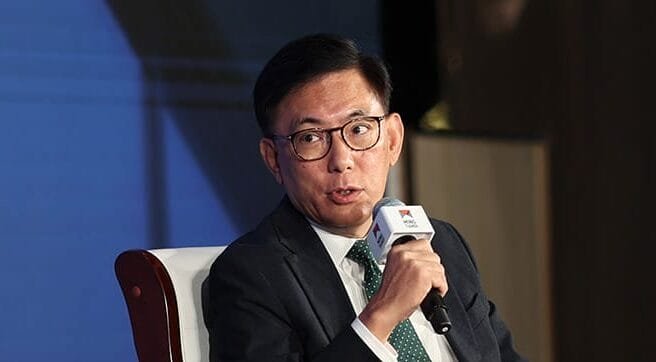Diversification across geographies and sectors, along with a disciplined approach to acquisitions and portfolio management, has provided Asia’s largest real estate investment trust with a buffer against a protracted downturn in Hong Kong and mainland China, Link REIT chief executive George Hongchoy told Mingtiandi’s Hong Kong Forum on Tuesday.
In a keynote interview, Hongchoy pointed to the trust’s nearly fully occupied retail and office properties in Australia as having helped offset challenges within its Hong Kong retail portfolio, with those assets having contributed to the continued growth of the Link REIT’s payout ratio, which has increased every year since the trust’s IPO nearly 19 years ago.
“Certainly in the last few years, in Hong Kong and China, retail has been challenging,” said Hongchoy. “That has been offset by our Australian shopping malls and office buildings that we have in Sydney and Melbourne…this has been a good filler of what we might have not been able to achieve just by relying on Hong Kong retail. So diversification has its benefit, and it has allowed us to continue to grow our payout.”
Asia’s largest real estate investment trust by market cap, which managed a portfolio of properties worth HK$241 billion as of September, had 74.8 percent of its holdings in Hong Kong assets by that juncture, compared to 91.8 percent within the SAR five years ago. Some 10.9 percent of the trust’s portfolio is now comprised of retail and office assets in Australia, Singapore and the UK.
Asset Lighter
Link REIT’s diversification drive, which forms part of its “Link 3.0” strategic plan, has seen the trust evaluating sectors and asset classes beyond its Hong Kong retail roots, including having submitted bids for Australian and mainland logistics portfolios, as well as studying opportunities in the Japanese market, Hongchoy said at the event, which was sponsored by Yardi.


“We’ve been very disciplined – when we put in a bid, if it doesn’t work out, we don’t chase, because there are always other deals,” said Hongchoy. “What I told our investment team is, look at everything. We never say no to looking at things. We look at hundreds of deals every year in order to do a few.”
Link REIT is also moving to adopt an “asset lighter” model by working with third-party capital partners to build out a fund management platform and bolster its payouts with income from management fees. The trust’s manager, which currently manages Link REIT exclusively, aims to ramp up its fund management business over the next 12 months, with joint ventures, co-investments and management contracts as potential structures.
“When we look at the two (property operations and fund management) together, we have, over the last one to two years, been able to convince our Board that these are two very good distinct businesses that we want to grow in parallel,” said Hongchoy.
The trust has made senior leadership appointments to facilitate its diversification strategy, including bringing on former BlackRock head of Asia Pacific real estate John Saunders as group chief investment officer in December. Link REIT has also recently brought in its chief operating officer for international, Greg Chubb, to work in its Hong Kong headquarters, after hiring the former Charter Hall retail executive in 2022.
Value-Add Acquisitions
While Link REIT has historically pursued a core and core plus strategy, the trust is now on the lookout for value-add and opportunistic deals to enhance yields.
Hongchoy pointed to the trust’s February acquisition of the remaining 50 percent stake it did not already own in the Qibao Vanke Plaza mall in Shanghai from joint venture partner China Vanke as an example of a value add play, with Link REIT repositioning the property after picking up the asset at a 26.3 percent discount to its appraised value.
Despite that discount, Hongchoy has not seen broader levels of asset repricing in Asia, which he attributed to the reluctance of banks in Asia to write off loans and put assets on the market, compared to their counterparts in the US.
Hongchoy also pointed to Link REIT’s portfolio as benefiting from a “flight to quality” trend, with all but one of the trust’s properties enjoying high 90 percent to 100 percent occupancy thanks to desirable asset locations and sound tenant selection.

